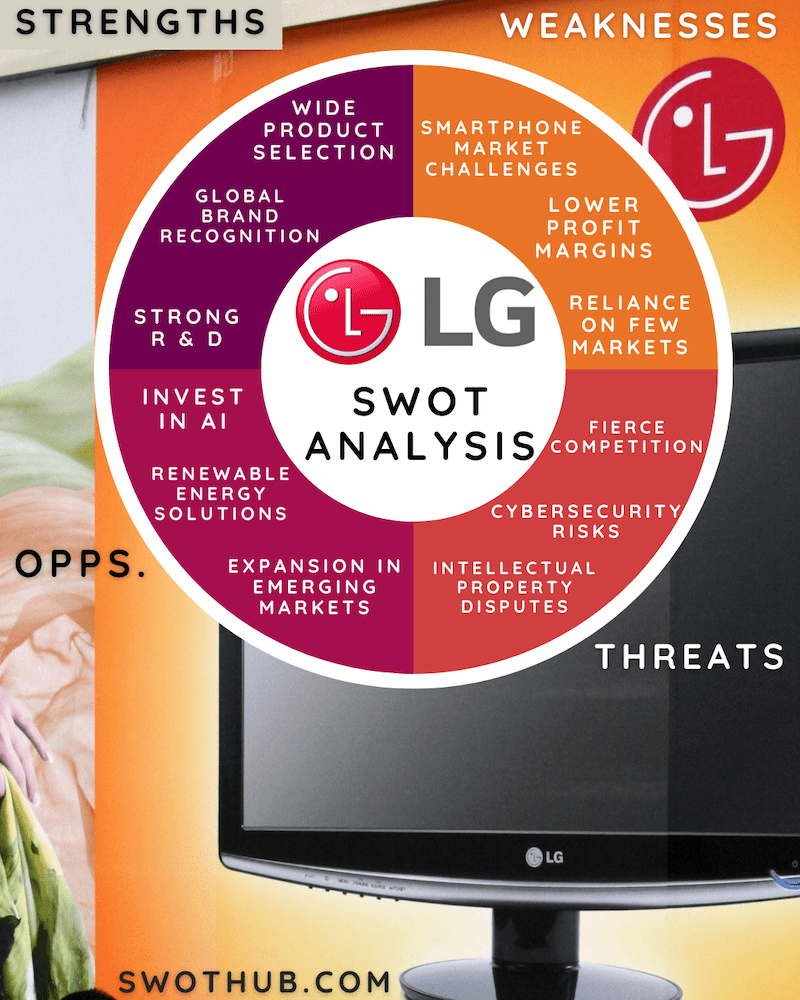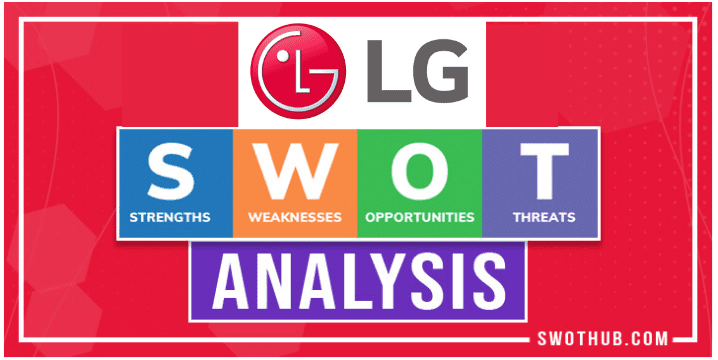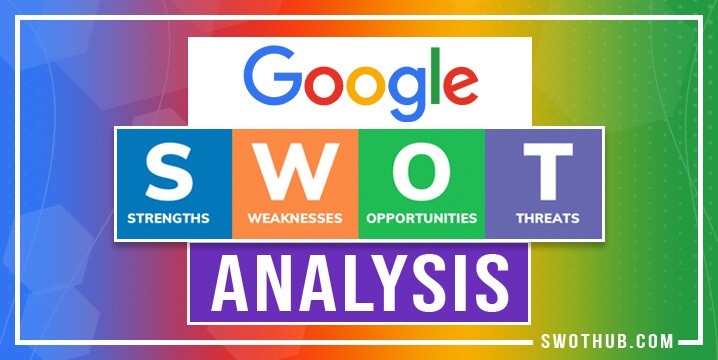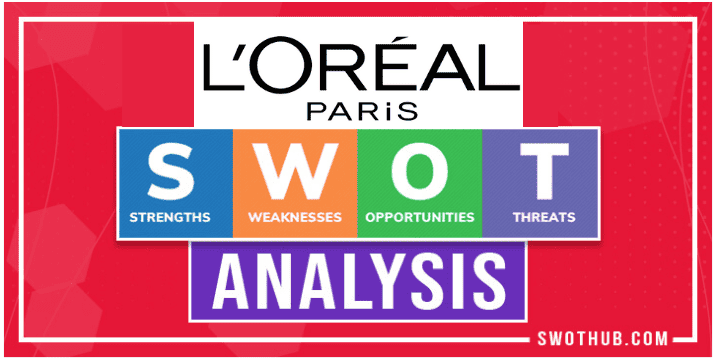The ultra-competitive electronics industry has been taken by storm by giants like Samsung, Apple, and Sony. In this LG SWOT analysis, we look at how smartphones, televisions, and smart appliances have made LG electronics a powerhouse of a company. Although, LG’s competitor – Samsung has been an extreme rival for years and LG’s weaknesses and threats could be an essential part of LG’s future of success.
Table of Contents
What does LG stand for?
In a LG SWOT analysis, to reflect its ambitions to be a global force and to encompass its wide range of product lines, the company changed its name to LG Electronics in 1995. The new moniker, “LG,” was created by fusing the words “Lucky” and “Goldstar.” To emphasize its dedication to enhancing people’s lives through technology, the company adopted the slogan “Life’s Good.”
LG’s History
Koo In-hwoi founded the South Korean multinational conglomerate corporation LG Corporation, formerly known as Lucky-Goldstar, in 1947. LG has played a significant role in the electronics world, contributing to advancements in various sectors, including home appliances, telecommunications, and consumer electronics.
Important events that shaped LG’s history and the electronics industry include:
In 1947, a chemical company by the name of “Lak Hui” (later pronounced “Lucky”) was the precursor to LG. As a sister company of Lucky Chemical, GoldStar, an electronics company, was founded in 1958. GoldStar began producing radios, which was the first step in its electronic journey.
Expansion and diversification During the 1960s and 1980s, LG expanded its product range by manufacturing South Korea’s first homegrown TVs, air conditioners, refrigerators, washing machines, and other home appliances. GoldStar was also instrumental in developing South Korea’s first telephone, black-and-white TV, and radio. In 1982, GoldStar opened its first research and development center in the U.S.
In a LG SWOT analysis, innovations in display technology from the 1990s to the 2000s: LG has played a significant role in the creation and adoption of cutting-edge display technologies. It produced the first 60-inch plasma TV in 1998, becoming a pioneer in the industry. In 2013, LG unveiled the first curved OLED TV in the world, demonstrating the company’s significant advancements in OLED and flexible display technology.
In the 2000s LG entered the market for cell phones and released a line of smartphones under its own brand. In the middle of the 2000s, LG’s Chocolate and Prada phones were particularly well-liked. The dual-screen LG V50 ThinQ and the swiveling LG Wing are just two examples of LG’s innovations, despite the company’s mobile division struggling in later years.
Home automation and the Internet of Things (IoT) (2010s–present): LG has been a leader in home automation, incorporating internet connectivity and AI technology into their products. The business has introduced ground-breaking products like the SmartThinQ line of home appliances and the LG Signature series, which meld cutting-edge technology and opulent design.
The history of LG is characterized by constant innovation, growth, and a dedication to enhancing consumers’ lives through technology. As a major player in the electronics world, LG has influenced various sectors and contributed to the development of advanced technologies and innovative products.
LG SWOT Analysis At-A-Glance
| Company | LG Electronics |
| Industry | Electronics |
| Founder | Koo In-Hwoi |
| Year founded | 1947 |
| CEO | Koo Kwang-Mo (Korea) / Thomas Yoon (USA) |
| Headquarters | Seoul, South Korea / Englewood Cliffs, N.J. (USA) |
| Number of employees | 259,915+ (2021) |
| Revenue (FY 2022) | KRW 80 Trillion (2022) |
…
How many divisions does LG have?
- LG Home Appliance & Air Solution – H&A
- LG Home Entertainment – HE
- LG Vehicle Component Solutions – VS
- LG Business Solutions – BS
LG SWOT Analysis:
A SWOT analysis is a framework used to assess a company’s competitive situation and to create strategic planning. By taking LG’s strengths, and weaknesses of LG’s threats of LG as well as opportunities of LG into account, we may better gain in-depth knowledge about LG company. In this article, we’ll be taking a look at LG’s SWOT framework to better understand its competitive position and potential for future growth. See how LG competitors fare against them and learn about LG’s Strengths, weaknesses, opportunities, and LG threats.
LG SWOT Analysis Strengths:
The areas where a company excels above average or in a manner that distinguishes it from its rivals are its strengths. LG’s strengths are outlined in this LG SWOT analysis. Some of its strengths in the context of LG Electronics, here are some key strengths in comparison to its competitors:
Product portfolio diversification: LG offers a wide selection of items in several different categories, including consumer electronics, telecommunications, home appliances, and renewable energy solutions. Due to its diversification, LG can reach a wide range of consumer segments while reducing the risks brought on by market fluctuations. LG has been a pioneer in developing and commercializing display technologies, such as OLED and flexible displays to give it a competitive edge.
Strong research and development (R&D): In a LG SWOT analysis it has an extensive global network of R&D facilities. LG has been able to develop cutting-edge technologies, maintain a competitive edge, and produce distinctive products that address customers’ shifting needs thanks to this investment in innovation.
Global brand recognition: LG has a well-established global presence, with its products available in more than 160 countries. The company’s strong brand equity and the tagline “Life’s Good” resonate with consumers, reflecting its commitment to enhancing people’s lives through technology.
Renewable energy and sustainability: LG has expanded into the renewable energy sector, focusing on solar power solutions. LG Solar, a division of LG Electronics, produces high-efficiency solar panels for residential, commercial, and utility-scale applications. The company is also committed to reducing its environmental impact through sustainable practices.
These strengths demonstrate LG’s ability to compete effectively and maintain a strong presence in the global electronics industry.
…

LG SWOT Analysis Weaknesses:
Weaknesses of a company are those that limit its potential, make it less competitive, and prevent it from achieving its goals. In this section of the LG SWOT analysis, we’ll look at LG’s weaknesses. Here are some key weaknesses of LG Electronics when compared to its competitors:
Smartphone market challenges: In an LG SWOT analysis, with declining market share and revenues over time, LG has had challenges in the fiercely competitive smartphone market. After failing to keep up with significant rivals like Samsung and Apple, the company eventually announced its exit from the mobile phone industry in 2021.
Marketing strategy messaging: LG has a history of using inconsistent marketing strategies. This inconsistency may have made it difficult for LG to distinguish itself from rivals in some markets and contributed to a lack of a distinct brand identity.
Lower profit margins: Compared to some industry leaders, LG has lower profit margins in certain product categories, which can limit its financial flexibility and ability to invest in innovation, marketing, and expansion.
Overreliance on a few markets: LG’s sales are disproportionately concentrated in a small number of markets, such as South Korea and the US. LG may be vulnerable to changes in consumer preferences and market trends if it depends too heavily on these markets and is thus exposed to variations in demand and local economic conditions.
Recognizing these weaknesses can help LG identify areas for improvement and develop strategies to enhance its competitiveness in the global electronics market.
LG SWOT Analysis Opportunities:
LG has an array of opportunities to explore! The following portion of the LG SWOT analysis will examine some of LG’s opportunities compared to competitors include:
Expansion into emerging markets: By providing reasonably priced, specially made products that cater to regional demands, LG can take advantage of the potential of emerging markets like those in India, Southeast Asia, and Africa. Due to their growing purchasing power and demand for consumer electronics, these markets present a sizable growth opportunity.
Focus on smart home and IoT technologies: LG has a chance to take advantage of its experience in home appliances and electronics to develop cutting-edge, networked products that serve the smart home market as the demand for IoT (Internet of Things) technologies and smart home appliances keeps rising.
Increasing the market share for renewable energy solutions: LG’s dedication to sustainability and renewable energy solutions, particularly in the solar power sector, presents a chance to do so. The need for renewable energy solutions is predicted to increase quickly as worries about climate change and energy security grow.
SWOT Analysis of LG Electronics
Development of 5G and advanced communication technologies: LG has the chance to take advantage of its telecommunications expertise to develop cutting-edge products and solutions for both consumer and industrial applications. This is due to the growing adoption of 5G networks and the demand for advanced communication technologies.
Investing in Artificial Intelligence (AI) and Machine Learning: AI and machine learning technologies have the potential to revolutionize consumer electronics, home appliances, and telecommunications. LG can capitalize on this opportunity by investing in AI research and integrating these technologies into its products and services.
By recognizing and pursuing these opportunities, LG can enhance its competitiveness, expand its market share, and strengthen its position in the global electronics industry.
LG SWOT Analysis Threats:
Threats pose a risk to every company’s stability and profitability. This LG SWOT analysis will address some of the threats that are important to examine.
Some of LG’s threats compared to competitors include:
Threats in a SWOT analysis refer to external factors that may challenge a company’s growth, profitability, or market position. Here are some key threats that LG Electronics faces when compared to its competitors:
Intense competition: The consumer electronics industry is highly competitive, with major players like Samsung, Apple, and Sony constantly innovating and launching new products. This fierce competition can lead to price wars, reduced profit margins, and a constant need for innovation, which can put pressure on LG’s market position and financial performance.
Regulation and compliance issues: In an LG SWOT analysis, LG operates in a number of nations and jurisdictions, subjecting it to a wide range of rules and obligations. LG’s global operations and market expansion strategies may be hampered by modifications to regulations, trade policies, or import/export limitations.
Intellectual property disputes: The consumer electronics industry is prone to intellectual property disputes and patent litigation. LG may face legal challenges or disputes with competitors regarding patents, trademarks, or other intellectual property rights, which can lead to financial losses and damage to its reputation.
Cybersecurity risks: As LG increasingly relies on digital technologies and connectivity, it becomes more vulnerable to cybersecurity threats. Cyberattacks targeting LG’s infrastructure, products, or customers can result in financial losses, damage to the company’s reputation, and potential regulatory penalties.
By acknowledging these threats, LG can develop proactive strategies to mitigate risks and maintain a competitive edge in the global electronics industry.
LG’s Largest Competitor – Is LG better than Samsung?
In a SWOT analysis of LG, its competitors would fall under the “threats” category. Samsung has topped the competitor chart of competitors that pose a significant threat to LG.
Look at our full Samsung SWOT analysis here to compare the two electronic brands.
LG Electronics SWOT Analysis – Conclusion and Recommendations:
LG needs to focus on a number of key strategies to remain competitive in the electronics industry.
A SWOT analysis of LG it highlights LG Electronics’ diverse product portfolio, strong R&D capabilities, global brand recognition, and expertise in display technology as key strengths. However, the company faces challenges such as struggles in the smartphone market, inconsistent marketing strategies, and lower profit margins compared to competitors. To stay ahead of the competition, LG should consider the following recommendations:
- Concentrate on core competencies: LG should prioritize bolstering its position in markets where it has a competitive advantage, including display technology, home appliances, and renewable energy solutions. By doing this, the business will be able to build on its advantages and become the market leader in these niches.
- Adopt emerging technologies: LG should spend money on researching and developing cutting-edge technologies like AI, machine learning, IoT, and 5G. As a result of incorporating these technologies into its product lineup, LG is able to develop novel solutions that appeal to consumers and keep a competitive edge in the rapidly developing electronics market.
- Expand in emerging markets: LG should target high-growth emerging markets by offering affordable and customized products tailored to local needs. This expansion can help the company diversify its revenue sources and reduce overreliance on specific markets.
- Enhance marketing strategies: LG should develop a consistent and focused marketing strategy that clearly communicates its brand identity and value proposition. By doing so, the company can differentiate itself from competitors and increase its appeal to consumers.
- Increase supply chain resilience: LG should work to increase its supply chain resilience by varying its suppliers and developing backup plans in case of disruptions. This strategy can aid the business in reducing risks related to supply chain insecurity.
FAQs for LG SWOT Analysis
What is LG’s strategy?
LG’s strategy focuses on innovation, diversification, and global presence. They invest heavily in research and development to create cutting-edge technology, diversify their product line to cater to various markets, and maintain a strong global network for widespread market reach.
What is the unique selling proposition of LG?
LG’s unique selling proposition is its combination of advanced technology, high-quality products, and user-centric design. The brand is renowned for integrating the latest technological advancements into reliable and aesthetically pleasing appliances and electronics.
What are the strengths and weaknesses of LG?
LG’s strengths lie in its strong brand reputation, diverse product range, and technological innovation. However, its weaknesses include high competition in the electronics market and a dependence on the global supply chain, which can be volatile.
By implementing these recommendations, LG can effectively address its weaknesses and capitalize on opportunities, allowing it to stay ahead of its competitors and maintain a strong presence in the global electronics industry.





